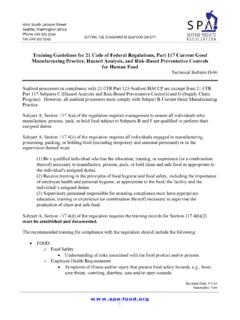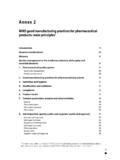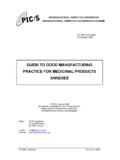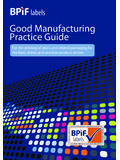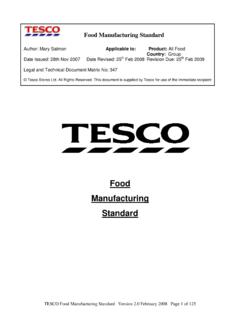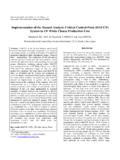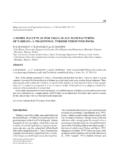Transcription of Feed Industry Hazard Analysis and Critical Control Point ...
1 Feed Industry Hazard Analysis and Critical Control Point (HACCP) Plan Auditor Manual May 2011. Office of the Texas State Chemist Texas A&M System Feed Industry HACCP Auditor Manual Version 3, May, 2011. TABLE OF CONTENTS. Part Section 1: Applicability ..1 Section 2: Section 3: Compliance ..2 Section 4: AAFCO Model Good Manufacturing Practice Regulations ..2 Section 5: Sanitation Section 6: Hazard Section 7: HACCP Section 8: Corrective Actions ..5 Section 9: Verification and Validation ..6 Section 10: Records ..8 Section 11: Training ..9 Part II Part III Auditor Part IV Hazard Guide ..22 Part V Model HACCP Appendices ..42 Appendix 1: Prerequisite Program ..42 Appendix 2: HACCP Plan Forms ..60 Appendix 3: HACCP Audit Report ..68 Appendix 4: Facility Application Sheet ..69 Appendix 5: Example Certificates ..71 i Feed Industry HACCP Auditor Manual Version 3, May, 2011. Part I. Section 1: Applicability Any establishment that adopts this program and manufactures, transports, or uses feed and/or feed ingredients will receive, store, manufacture, process, package, label, distribute and use the feed and/or feed ingredients in accordance with the standards of this part.
2 Section 2: Definitions (a) Adulteration means the presence of any poisonous or deleterious substance at a level that may render feed and/or feed ingredients injurious to human or animal health, as provided in Section 7(a), (d), of the AAFCO Model Bill including the presence of any poisonous or deleterious substance at levels in excess of official regulatory standards. (b) Animal Hazard means any biological, chemical, or physical agent in a feed and/or feed ingredient that is reasonably likely to cause illness or injury in the absence of its Control to animals. (c) Control means: 1) to manage the conditions of an operation to maintain compliance with established criteria; and 2) the state where correct procedures are being followed and criteria are being met. (d) Control measure means any action or activity to prevent, reduce to acceptable levels, or eliminate an animal or human Hazard . (e) Critical Control Point (CCP) means a Point , step, or procedure at which Control can be applied and is essential to prevent or eliminate a human Hazard or reduce it to an acceptable level.
3 (f) Critical limit means the maximum or minimum value to which a physical, biological, or chemical agent must be controlled at a Critical Control Point to prevent, eliminate, or reduce to an acceptable level the occurrence of the identified human Hazard . (g) Establishment includes, but is not limited to, buildings, structures, facilities, equipment and conveyances that receive, store, manufacture, process, package, label, transport or distribute feed and/or feed ingredients. (g) Human Hazard means any biological, chemical, or physical agent in a feed and/or feed ingredient that is reasonably likely to cause illness or injury in the absence of its Control to humans. 1. Feed Industry HACCP Auditor Manual Version 3, May, 2011. (h) Monitor means to conduct a planned sequence of observations or measurements to assess whether a Critical Control Point is under Control and to produce an accurate record for use in verification. (i) Prerequisite Programs means procedures, including those set forth in the AAFCO Model Good Manufacturing Practice Regulations for Feed and Feed Ingredients that address operational conditions providing the foundation of the HACCP plan.
4 (j) Significant means significant risk to consumer health with reference to a potential Hazard , as determined during the Hazard evaluation stage of Hazard Analysis . (k) Validation means collecting and evaluating scientific and technical information to determine whether the HACCP plan, when properly implemented, will effectively Control the identified animal and human hazards . (l) Verification means those activities, other than monitoring, that establish the validity of the HACCP plan and that the system is operating according to the plan. Section 3: Compliance Establishments and suppliers to those establishments will be in compliance with any applicable federal and/or state/provincial/tribal laws and regulations governing the feed and/or feed ingredients. Section 4: AAFCO Model Good Manufacturing Practice Regulations AAFCO Model Good Manufacturing Practices Regulations for Feed and Feed Ingredients applies in determining whether the facilities, methods, practices, and controls of the establishment used during the manufacture and distribution of feed and feed ingredients are sufficient to minimize risk of adulteration of such products.
5 Section 5: Sanitation Control If determined necessary to Control animal and human hazards during the Hazard Analysis , each establishment will include and implement within their prerequisite programs or HACCP Plan a sanitation standard operating procedure (SSOP) or standard operating procedure (SOP) that addresses sanitation conditions and practices before, during, and after processing and will be included in the prerequisite program or HACCP plan. 2. Feed Industry HACCP Auditor Manual Version 3, May, 2011. Section 6: Hazard Analysis (a) Each establishment will conduct and document a Hazard Analysis to determine the animal and human hazards that are reasonably likely to occur at each process step if not effectively controlled. The written Hazard Analysis will identify Control measures for hazards that prevent, eliminate or reduce those hazards to an acceptable level to minimize adulteration. (b) The written Hazard Analysis will include the following: (1) Identification of animal and human hazards .
6 (2) An evaluation of each Hazard identified to determine if the Hazard is reasonably likely to occur and, thus, constitutes a significant Hazard that will be addressed. This evaluation will include an assessment of the severity of the Hazard based upon risk assessment, experience, animal sickness, human sickness, data, scientific reports, or other information. (3) Identification of the Control measures that the establishment can apply to the significant hazards . a. Prerequisite programs will be used as Control measures for animal hazards . b. Control measures for human hazards that cannot be fully controlled by prerequisite programs will be included in the HACCP Plan. (4) An evaluation of the establishment's SOPs to determine whether modifications are necessary; and (5) Identification of CCPs to prevent, eliminate, or reduce to an acceptable level significant human hazards . (c) The Hazard Analysis will consider hazards that may be present or introduced into feed and/or feed ingredients from both external sources and internal operations within the establishment.
7 The Hazard Analysis will be subject to the recordkeeping requirements of section 10 and will be conducted by the HACCP. team or individuals who have been trained in accordance with section 11. (d) In evaluating hazards , consideration will be given, at a minimum, to the following: (1) Biological a. Microbiological contamination b. Parasites c. Prohibited mammalian protein d. Decomposition in feed and feed ingredients when a Hazard has been associated with decomposition 3. Feed Industry HACCP Auditor Manual Version 3, May, 2011. (2) Chemical a. Veterinary medications b. Pesticide/industrial contaminants c. Natural toxins, including toxic plants d. Heavy metals e. Minerals f. Unapproved feed ingredients g. Unapproved food additives (3) Physical a. Stones b. Wood c. Metal d. Glass e. Plastic (e) Each establishment will evaluate the following areas to determine the potential effect of each on the possible adulteration of the feed and/or feed ingredients.
8 (1) Process steps, packaging, storage, transportation, and intended use of feed and/or feed ingredients;. (2) Facility and equipment function and design; and (3) Plant sanitation, including employee hygiene. Section 7: HACCP Plan (a) An establishment adopting HACCP will develop a HACCP plan when the Hazard Analysis reveals one or more significant human hazards at a process step, as described in section 6. Individual(s) who develop the HACCP plan will be trained in accordance with section 11 and a record of that training is required in accordance with section 10. A HACCP plan will be specific to: (1) Each location where feed and/or feed ingredients are manufactured or used by that establishment. (2) Each type of feed and/or feed ingredient manufactured, transported or used by the establishment. Similar feed and/or feed ingredients may be grouped together, if the hazards , Critical Control points, and Critical limits required to be identified and procedures required to be identified and performed by paragraph (b) of this section are essentially identical.
9 (b) The HACCP plan will, at a minimum: 4. Feed Industry HACCP Auditor Manual Version 3, May, 2011. (1) List all significant human hazards identified in accordance with section 6. that will be controlled at the identified process step;. (2) List the CCPs for each of the significant human hazards , including as appropriate: a. CCPs designed to Control hazards that could be introduced inside the establishment; and b. CCPs designed to Control hazards introduced outside the establishment;. (3) List the Critical limits that will be met at each of the CCPs;. (4) List the procedures that will be used to monitor each of the CCPs, and the frequency with which they are to be performed to ensure adherence to Critical limits;. (5) Include any corrective action plans that have been developed in accordance with section 8 (a), and that are to be followed in response to deviations from Critical limits;. (6) List the validation and verification procedures, and the frequency with which they are to be performed, that the establishment will use in accordance with section 9; and (7) Provide for a recordkeeping system that documents the monitoring of the CCPs in accordance with section 10.
10 The records will contain the actual values and observations obtained during monitoring. Section 8: Corrective Actions Whenever a deviation from a Critical limit occurs, the establishment will take corrective action by following the procedures set forth in paragraph (a) or paragraph (b) of this section. (a) Establishments will develop written corrective action plans by which establishments predetermine the corrective action to be taken whenever there is a deviation from a Critical limit. Such written corrective action plans will be incorporated into the HACCP plan, in accordance with section 7 (b)(5). A. corrective action plan that is appropriate for a particular deviation is one that describes the steps to be taken and assigns responsibility for taking those steps, to ensure that: (1) No feed or feed ingredient adulterated as a result of the deviation is distributed or used after the deviation has been identified and before corrective actions are taken; and 5.
